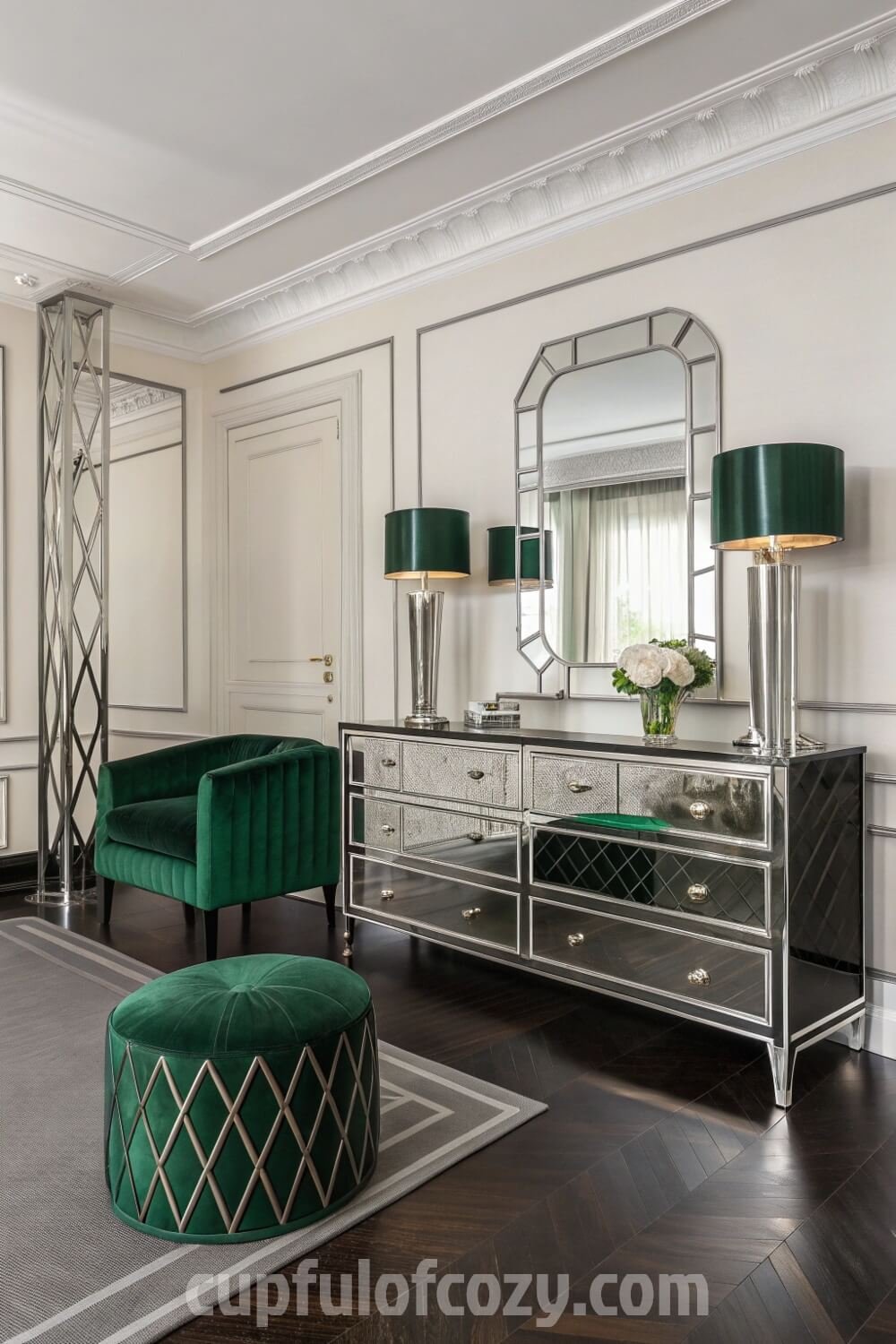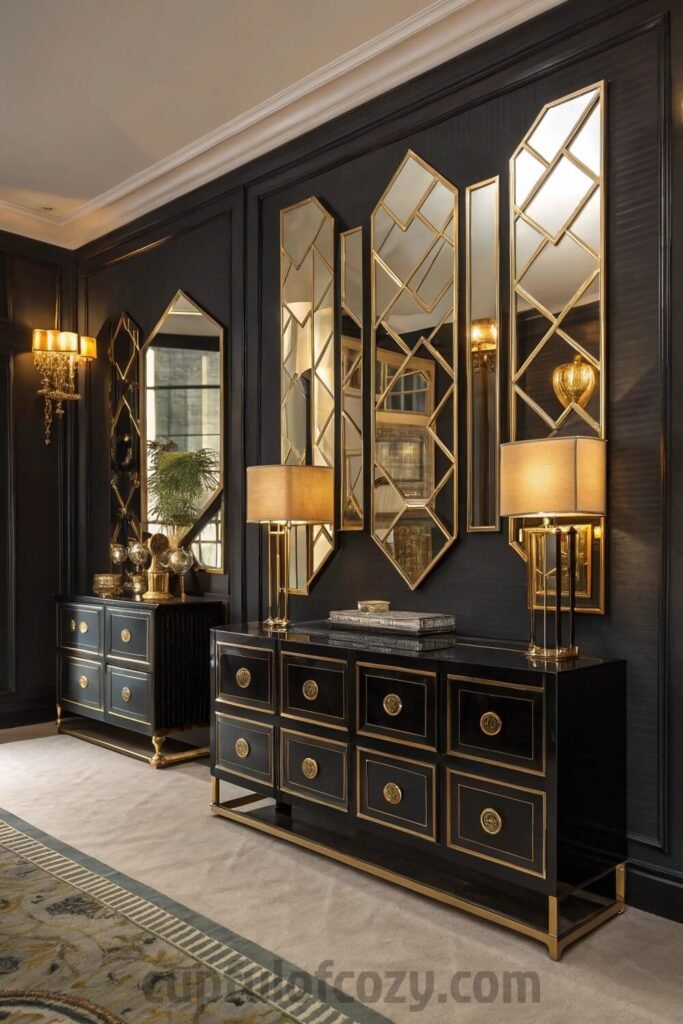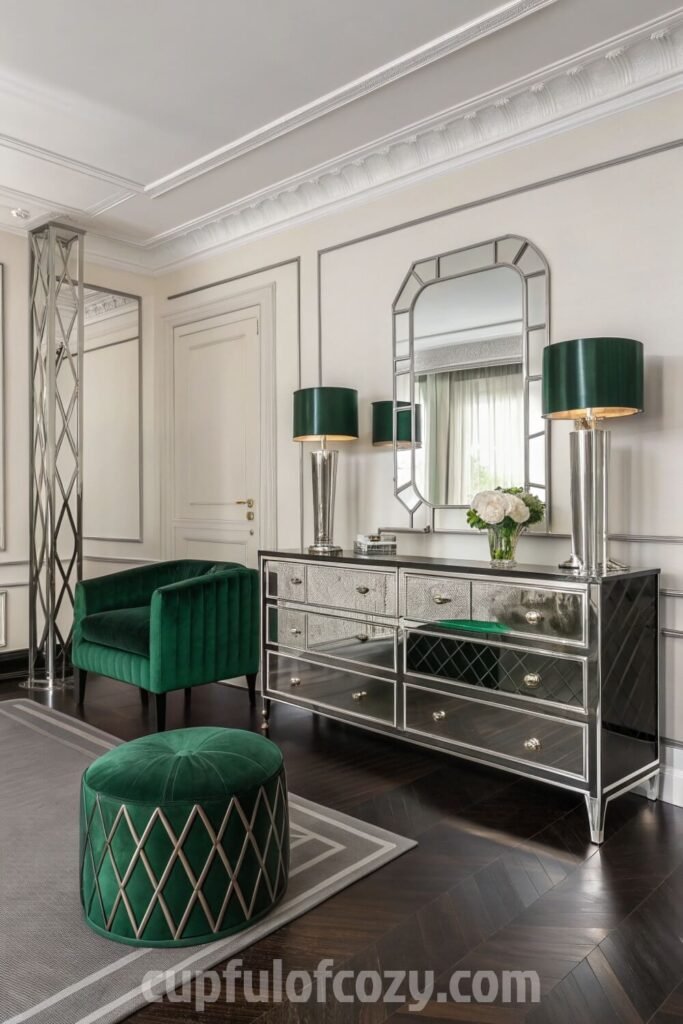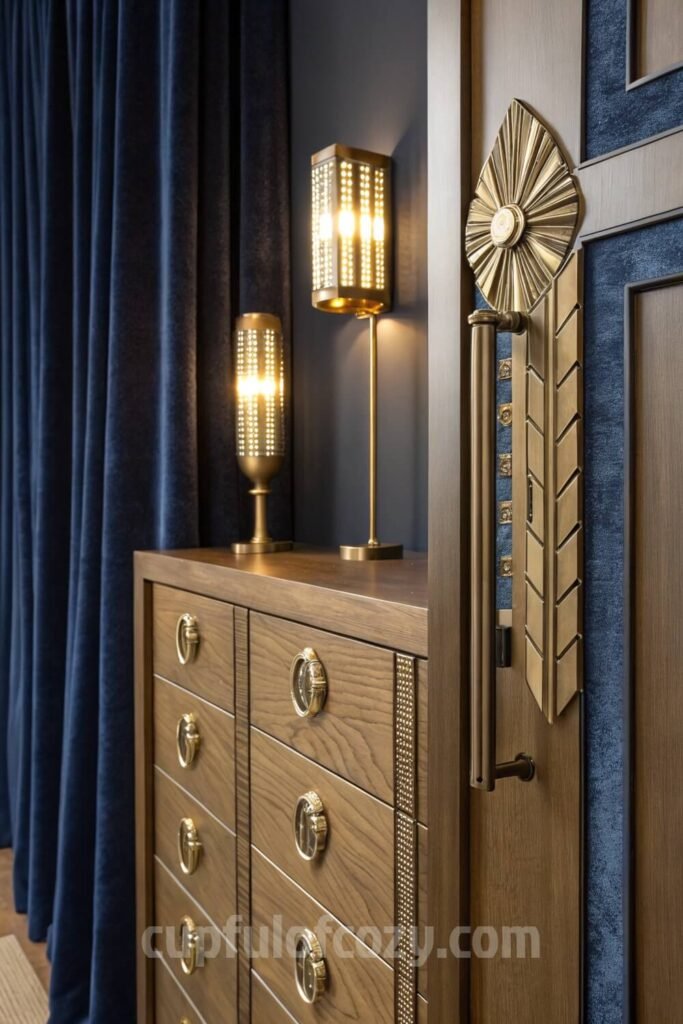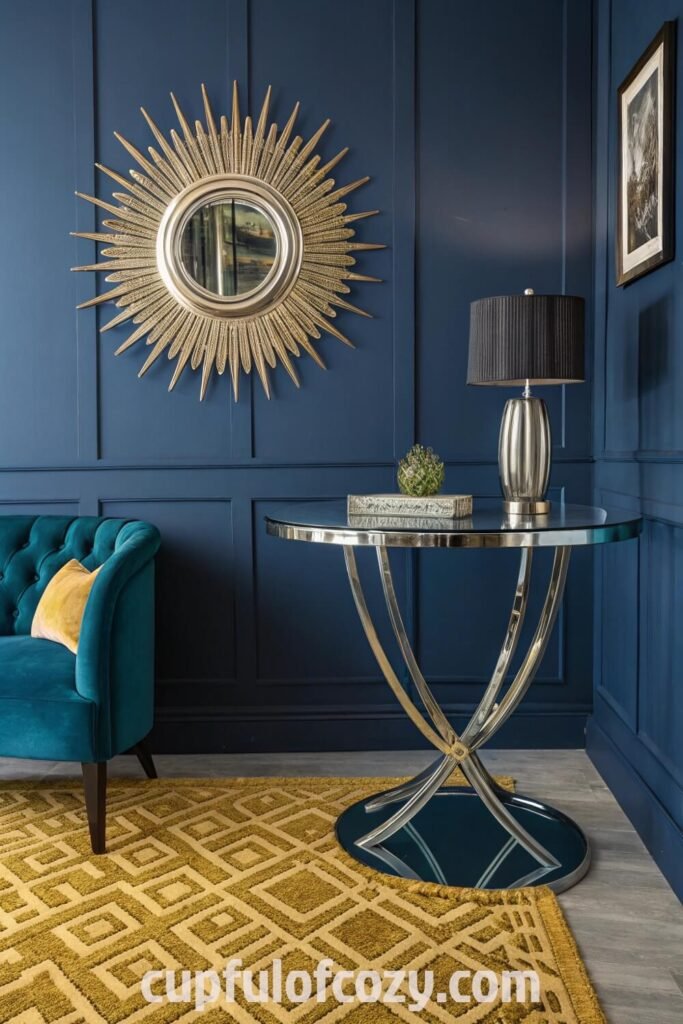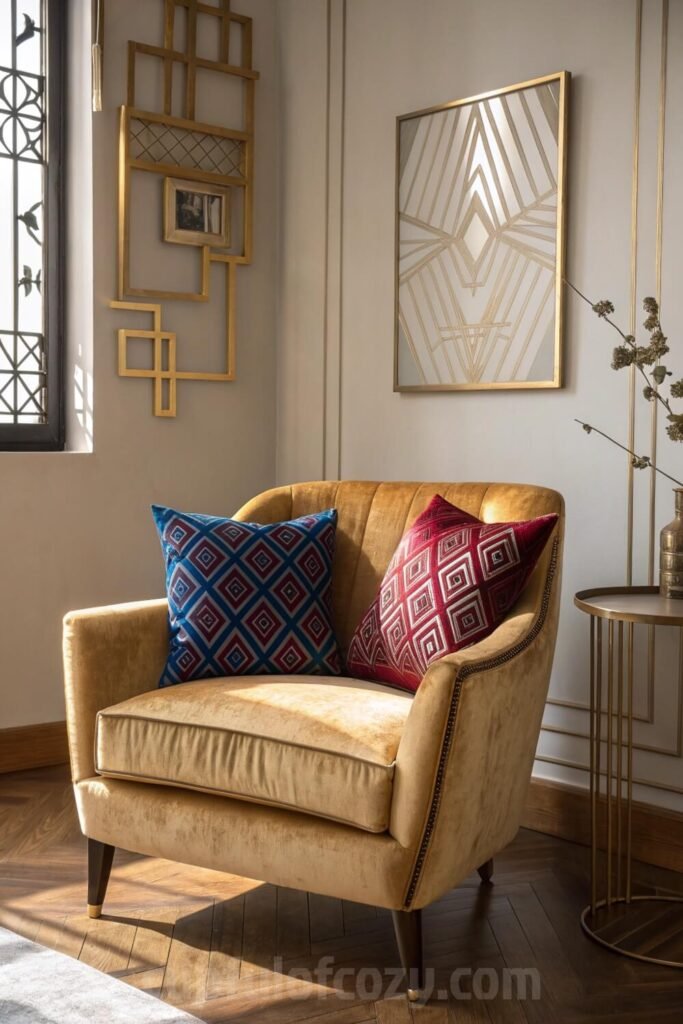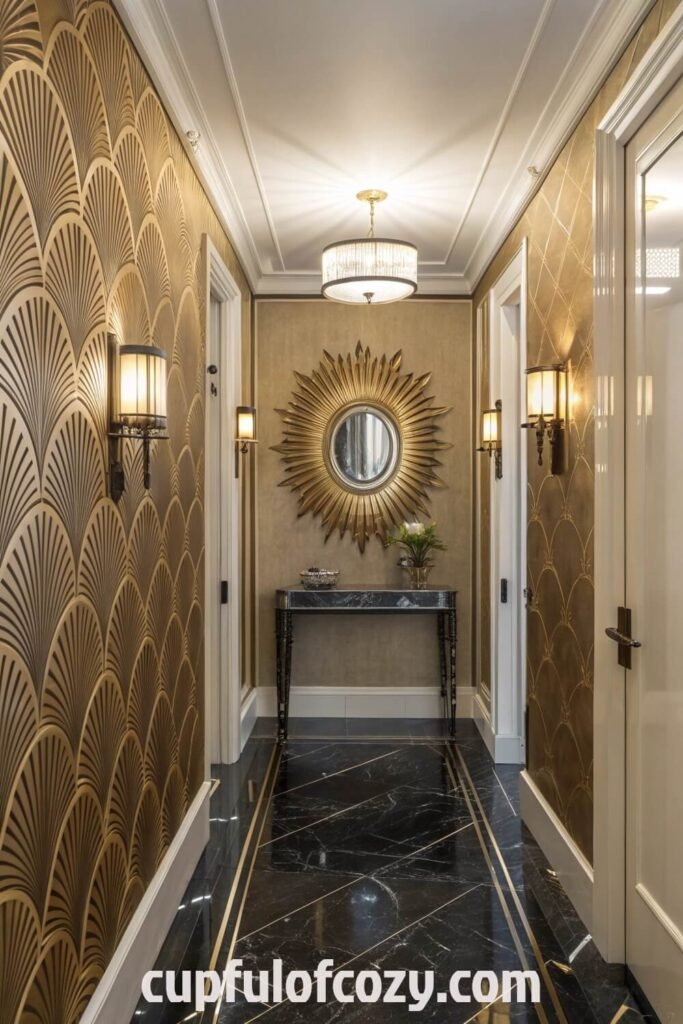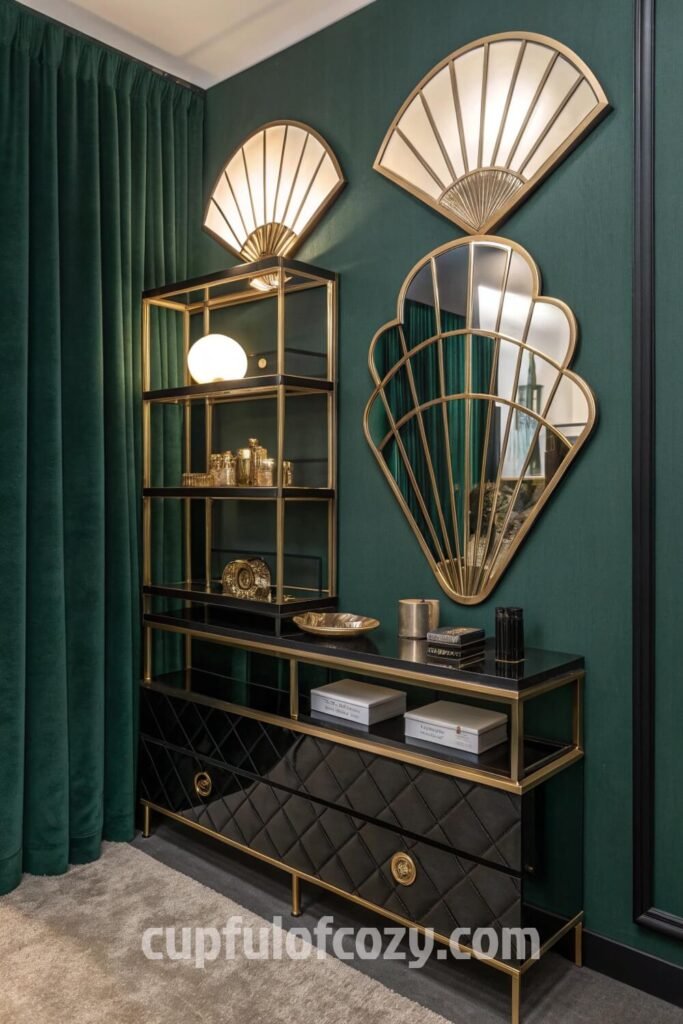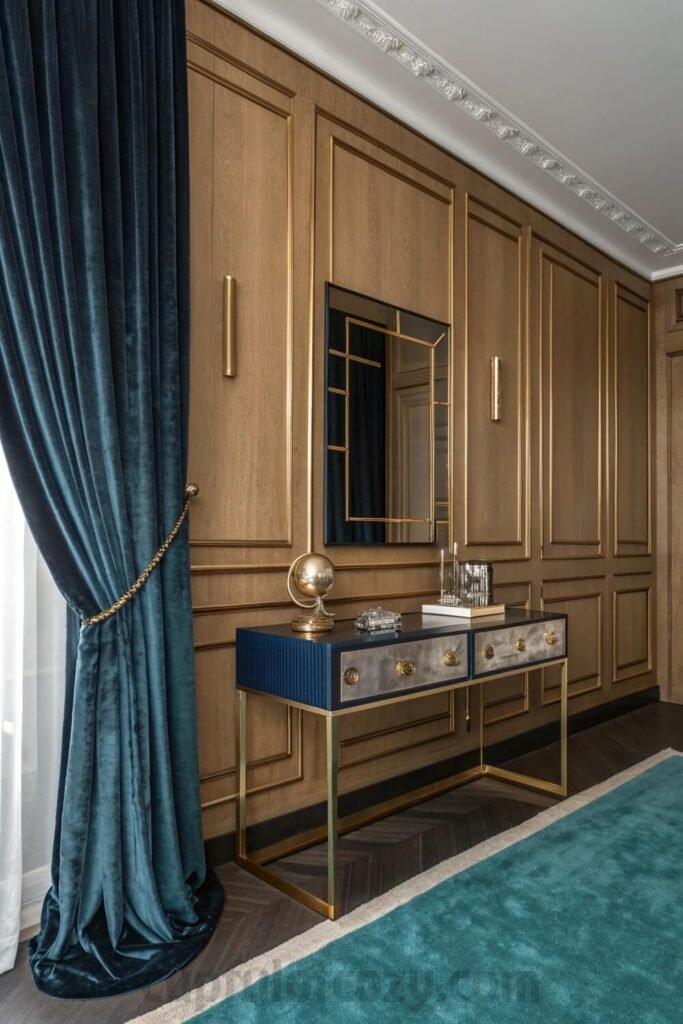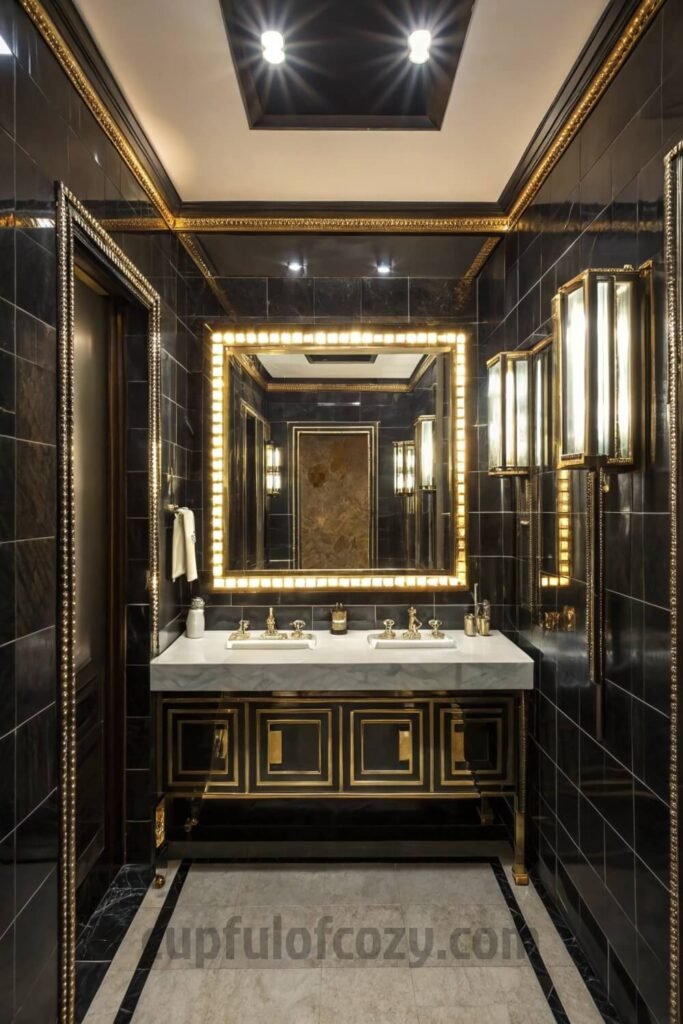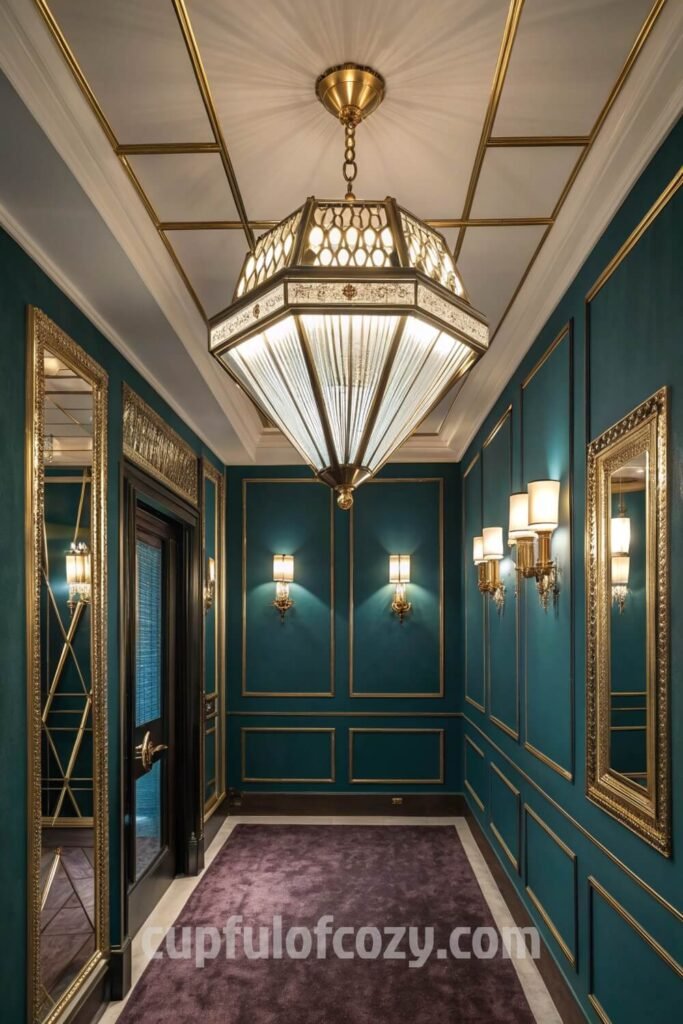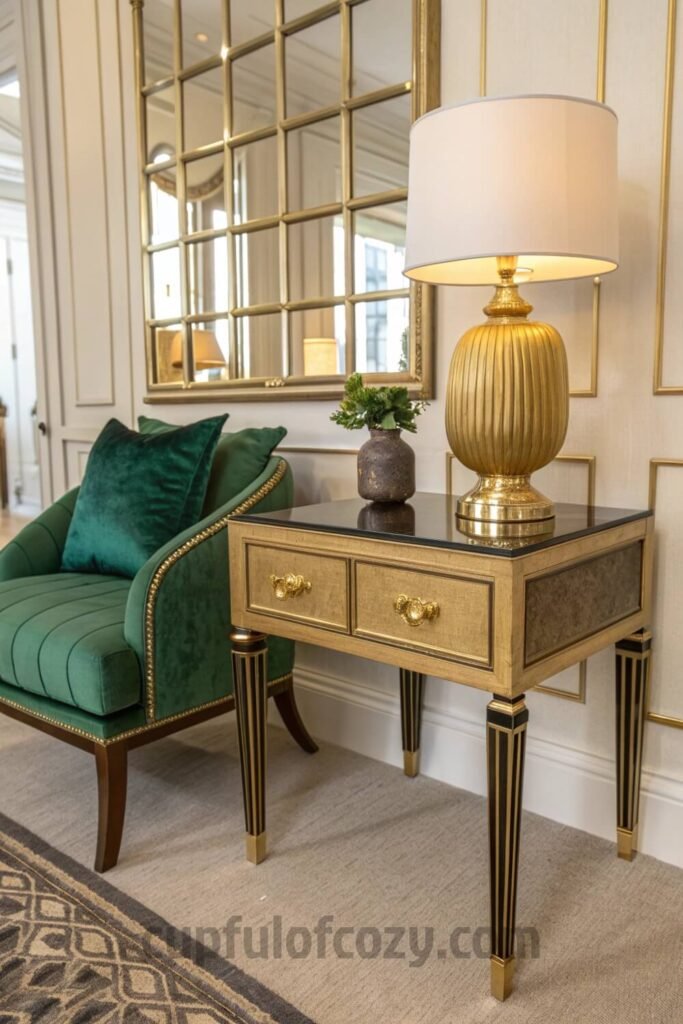I saw a tiny studio apartment that literally made me gasp out loud last month. Like, actual audible gasp that made my roommate ask if I was okay. This place was maybe 350 square feet, but it looked like something straight out of The Great Gatsby. Every single surface was catching light, bouncing it around, creating these incredible reflections that made the whole space feel like it went on forever.
That’s when I realized I’d been thinking about small spaces all wrong. I’d been so focused on “opening things up” with whites and light colors, trying to make everything disappear. But this apartment? It was bold, it was metallic, it was full of mirrors and geometric shapes, and somehow it felt twice the size of my 600-square-foot place. The owner had this whole Art Deco thing going on, and every single element was working overtime to create space and drama.
I immediately called my mom, because she’s the one who taught me to notice beautiful spaces. She grew up in this old building in Chicago with these incredible 1920s details, and she’s always telling stories about the lobby with its geometric mirrors and brass mailboxes. “Art Deco never went out of style,” she always says, “people just forgot how to do it right.” And looking at this apartment, I finally understood what she meant.
See, Art Deco isn’t just about the roaring twenties or fancy hotels. It’s about using reflection, metallics, and geometric shapes to create luxury and space where there isn’t much to work with. It’s about being smart with every single design choice so that each mirror, each metallic finish, each carefully placed light fixture is doing double or triple duty. When you live in a small space, you can’t afford to have anything that’s just decorative. Everything needs to work.
The more I researched, the more I realized that Art Deco is actually perfect for small homes. Those 1920s designers were dealing with urban apartments, narrow townhouses, compact spaces where every square foot mattered. They figured out how to make small feel grand, how to use manufactured materials like chrome and glass to create elegance, and how to play with reflection and light to fool the eye into seeing more space than actually exists.
So I spent the next three weeks completely redesigning my place using these principles, and I’m not even exaggerating when I say it’s changed everything. My friends keep asking if I moved to a bigger apartment. My sister wants to hire me to redo her place. Even my landlord commented on how much more spacious it looks when he came by to fix my kitchen sink last week.
The best part? Most of these changes didn’t cost me a fortune. I’m talking strategic mirror placement, some well-chosen metallic accents, and a few key furniture swaps that made all the difference. Art Deco is about being clever, not expensive. It’s about understanding how light works, how reflection creates depth, and how the right geometric shapes can make your brain think there’s more room than there actually is.
These eleven tips are everything I learned from that Instagram apartment, my mom’s stories, hours of research, and my own trial and error over the past few months. Some of them you can do this weekend with a trip to the thrift store and a can of spray paint. Others might require saving up for a few months, but trust me when I say the impact is worth every penny.
Table of Contents
1. Go Bold with Geometric Mirrors as Statement Pieces
Here’s what gets me excited about geometric mirrors: they’re not trying to disappear into your wall like regular mirrors. They’re making a statement while secretly doing all this incredible work to expand your space. I found this hexagonal mirror at an estate sale three weeks ago, and the woman selling it told me it came from her grandmother’s Art Deco apartment in Manhattan. The thing is probably 70 years old, but when I hung it in my living room, suddenly that weird dead space above my couch became the most interesting part of the room.
What I love about geometric shapes is how they create this perfect balance between being eye-catching and functional. A sunburst mirror isn’t just reflecting light, it’s creating this radiating pattern that makes your walls feel like they extend beyond their actual boundaries. My cousin Sarah did this whole mirror wall in her studio with these diamond-shaped mirrors she found online, and when you walk into her place, you literally can’t tell where the room ends. It’s wild.
The key with statement mirrors is placement. Don’t just stick them anywhere, think about what they’ll be reflecting. That hexagonal mirror I mentioned? It’s positioned perfectly to catch the light from my side window and bounce it toward my kitchen area, which used to be this dark corner where I’d stub my toe every morning. Now it’s bright and feels connected to the rest of the space.
2. Invest in Mirrored Furniture That Works Double Duty
- Before you hit “buy” on your next decor order, there’s a free 10-second step you should never skip: checking Rakuten (Ebates). I simply find the store name, click the deal, and shop like normal, and Rakuten sends me real cashback! Prices keep climbing everywhere, but this is one way to get a little back on the things you were going to purchase anyway. New members even get a $30 bonus when they spend $30 — which means your first order could pay you back instantly. Don’t miss out again. Click here to sign up and save money!
*Disclosure: This post includes affiliate links. I may earn a small commission if you join Rakuten through my link — but it doesn’t cost you anything extra. In fact, you’ll actually save more!
Mirrored furniture used to seem so fancy and untouchable to me, like something that belonged in a museum or my rich aunt’s house. Then I started seeing it in these small space makeovers, and I realized it’s actually the smartest furniture choice you can make when you’re dealing with limited square footage. Every piece is basically invisible while still being completely functional.
I scored this mirrored console table at a vintage shop in Taos, and the owner told me these were huge in the 1970s when everyone was trying to recreate that 1920s glamour. The chrome frame has these subtle Art Deco curves that make me smile every time I walk past it. But here’s the thing that really sold me: I can pile it with mail, keys, plants, whatever, and because the surface is mirrored, it doesn’t look cluttered. Everything just sort of floats.
Mirrored dressers are incredible in bedrooms because they reflect the window light and make the whole room feel brighter. My friend Emma has this vintage one with a chrome frame that she inherited from her grandmother, and her tiny bedroom feels like it has twice as much natural light as mine. Even cocktail tables with mirrored tops work wonders in small living rooms, they’re there when you need them but they don’t take up visual space.
3. Add Metallic Finishes in Small Doses for Maximum Impact
This is where I see people mess up constantly, and honestly, I did it too at first. They think Art Deco means everything has to be gold and shiny and over-the-top. But the real secret is restraint. It’s about those little metallic touches that catch your eye and make everything feel more expensive without looking like you’re trying too hard.
I started with cabinet hardware because it’s the easiest swap and has the biggest impact. Switched out all my basic knobs for these brushed brass pulls that cost maybe forty bucks total, and suddenly my kitchen went from “generic rental” to “someone with actual taste lives here.” Door handles, drawer pulls, picture frames, lamp bases, these small details add up to create this cohesive, luxurious feeling.
Light fixtures are where you can be a little bolder with metallics. I found this brass pendant light at a vintage market that the seller said came from a 1920s office building. It has this geometric shade with frosted glass that diffuses the light beautifully, and the brass finish ties together all the other metallic accents in my space. My mom always said that lighting can make or break a room, and she’s absolutely right.
4. Mix Glass and Chrome Tables Like a Pro
Glass and chrome together is pure Art Deco genius. There’s something about how these materials work together that just screams sophisticated without being stuffy. I have this side table that’s literally just a piece of glass supported by this curved chrome base, but the proportions and that subtle curve make it feel like a piece of sculpture.
What I love about glass-top tables is how they don’t compete with anything else in the room. You can put books on them, plants, candles, whatever, and because you can see through to the floor, they don’t make your space feel crowded. My coffee table is this vintage chrome and glass piece I found on Facebook Marketplace, and even though it’s actually pretty substantial, it doesn’t make my small living room feel cramped.
The chrome bases are what give these pieces their Art Deco character. Look for ones with geometric details or those signature curves that were so popular in the 1920s and 30s. They catch light just like mirrors do, creating these little reflections that add sparkle and movement to your space. It’s functional furniture that doubles as decor.
5. Bring in Shimmer Through Textiles
Metallic threads in fabric is one of those details that most people miss, but once you start noticing it, you can’t stop. I have these throw pillows in deep emerald velvet with gold threading that I found at this little shop in Santa Fe, and they’re honestly the most complimented thing in my apartment. The way the gold catches the light is subtle but adds this incredible richness.
The trick is choosing jewel tones as your base, then adding just enough metallic thread to create interest. Deep blues with silver, rich burgundy with gold, forest green with copper. These combinations feel sophisticated and timeless, not trendy or flashy. My grandmother had these curtains in her dining room, deep navy with silver threads running through them, and they made her little breakfast nook feel like the most elegant room in the house.
Upholstery with metallic threads is an investment, but if you find the right piece, it becomes the foundation for your whole color scheme. I’ve been saving up for this Art Deco armchair I saw at an antique shop, navy velvet with gold threading in this geometric pattern. The owner told me it’s from the 1930s, and every time I visit, I sit in it and imagine how incredible it would look in my living room.
6. Create Drama with Decorative Metal Wall Panels
Wall panels might sound intimidating, but they’re actually one of the easiest ways to add serious Art Deco drama to a small space. I’m talking about one accent wall that becomes the focal point of your entire room. My friend Lisa did this in her dining area with this geometric metal wallpaper in gold, and suddenly her little corner breakfast nook felt like a high-end restaurant booth.
What gets me excited about metallic wallpaper is how it plays with light throughout the day. In the morning, it’s subtle and soft. By evening, with your lamps on, it’s creating these incredible patterns and shadows on the opposite walls. It’s like having artwork that changes depending on the lighting, which is such smart design for small spaces where every wall needs to work hard.
Metal wall panels are another option if you want something more three-dimensional. I’ve seen these used behind headboards in bedrooms, above mantels in living rooms, even in bathrooms to create a luxury spa feeling. The key is choosing one wall and really committing to it, then keeping the other walls simpler so your metallic accent can be the star.
7. Choose Beveled Edge Mirrors with Personality
Regular flat mirrors are fine, but beveled edge mirrors are where the real Art Deco character comes from. Those angled edges catch and bend light in ways that create these beautiful prismatic effects, especially when the sun hits them just right. I found this fan-shaped mirror at a thrift store that was probably someone’s pride and joy in the 1960s when Art Deco was having a revival moment.
The frames matter just as much as the mirror itself. Gilded metal, polished chrome, anything with geometric details or those classic Art Deco motifs. I love mirrors that look like they have stories, that feel like they’ve witnessed decades of people getting ready for important nights out. There’s character in aged brass, beauty in chrome that’s been polished by countless hands.
Fan shapes, starbursts, geometric patterns, these aren’t just decorative choices. They’re creating visual interest while reflecting light in multiple directions. That fan mirror in my bathroom makes the whole space feel bigger because it’s bouncing light into corners that would otherwise be dark. Function and beauty working together, which is what Art Deco is all about.
8. Balance All That Shine with Softer Textures
Here’s something I learned the hard way: you can absolutely have too much of a good thing when it comes to metallics and mirrors. I went through this phase where I was so excited about adding shine that my living room started feeling cold and impersonal, like a high-end showroom where nobody actually lived.
Velvet is your best friend for balancing all that metallic shine. Deep, rich colors that absorb light instead of reflecting it, textures that invite you to touch them. I added these burgundy velvet curtains to my living room, and suddenly all my chrome and brass accents felt warm and inviting instead of stark. The contrast between soft velvet and hard chrome is visually interesting and emotionally comforting.
Wood trim painted in jewel tones is another way to add warmth. My kitchen has these original 1940s cabinets, and instead of painting them white like everyone suggested, I went with this deep forest green. Combined with the brass hardware and my mirrored backsplash tiles, it feels rich and sophisticated, not cold or clinical.
9. Use Strategic Mirror Placement for Maximum Light
This tip is pure science, but the results feel wonderful. Mirrors placed opposite or adjacent to windows will catch natural light and bounce it deeper into your space. It’s like having extra windows without the construction costs. My bedroom used to be this dark cave until I hung a large geometric mirror directly across from my only window.
In narrow spaces like hallways or entryways, mirrors can completely change the proportions. I have this long, skinny hallway that felt like a tunnel until I hung three small hexagonal mirrors down one wall. Now it feels wider and more interesting, plus the mirrors catch light from the living room and reflect it all the way to the front door.
Bathrooms are where strategic mirror placement really shows off. Small powder rooms can feel claustrophobic, but a large Art Deco mirror with good lighting will make the space feel twice as big. My bathroom is tiny, maybe 4×6 feet, but with the right mirror positioned to catch light from the frosted window, it doesn’t feel cramped anymore.
10. Invest in Statement Art Deco Lighting
Lighting fixtures in Art Deco style aren’t just functional, they’re jewelry for your room. I saved up for months to buy this brass and frosted glass pendant light for my dining area, and it’s honestly the best money I’ve spent on my apartment. Every single person who comes over comments on it because it’s that perfect combination of beautiful and practical.
Chandeliers might seem too fancy for small spaces, but the right one can actually make a low ceiling feel higher. The key is choosing something with clean geometric lines rather than lots of dangling crystals. I’ve seen small Art Deco chandeliers in studio apartments that become the focal point of the entire space, drawing your eye up and making the room feel more spacious.
Wall sconces are incredible for adding ambient light without taking up floor or table space. Look for ones with frosted glass shades and metallic accents that complement your other finishes. They create this warm, even lighting that makes small spaces feel cozy and sophisticated at the same time.
11. DIY Your Way to Art Deco Glamour on a Budget
The most satisfying part of this whole Art Deco journey has been discovering how much you can accomplish with creativity instead of cash. Gold spray paint is seriously underrated as a design tool. I completely refreshed this basic wooden dresser I’ve had for years by spray painting the handles and adding some geometric trim details with painter’s tape.
Thrift stores are goldmines for pieces with good bones that just need some metallic love. Last weekend I found this plain mirror with an interesting shape for eight dollars. A can of chrome spray paint and some careful masking, and now I have what looks like a vintage Art Deco mirror that could have cost ten times as much at a fancy home store.
The trick with DIY is choosing pieces that already have interesting shapes or proportions. You’re not trying to create Art Deco details from scratch, you’re enhancing what’s already there. A simple geometric lamp base becomes stunning with the right metallic finish. Basic picture frames become sophisticated with some gold leafing. Even cabinet hardware can be transformed with careful painting and new finishes.
What I love most about incorporating Art Deco elements into small spaces is how every single change makes such a big impact. These aren’t subtle design choices that only other designers will notice. When you add mirrors that double your light, metallics that catch every sparkle, and geometric shapes that create visual interest, the transformation is immediate and dramatic. Your space doesn’t just look different, it feels different. More spacious, more sophisticated, more like the glamorous home you’ve always wanted.
Related posts:
10 Genius & Stylish Farmhouse Open Shelf Ideas for Kitchen Storage - Mixing Glass, Wood, Greener...
Last-Minute Halloween Room Decor Using Things You Already Own
How to Turn a Plain Winter Entryway Into a Cozy Holiday Entrance Welcome Spot in 1 Hour
9 Halloween Candle Decor That Doubles as a Spa Moment at Home
- Before buying anything online, check Rakuten (formerly Ebates) — either with the browser extension or directly on Rakuten.com. Just type in your store, click the current deal, and shop as usual. Every purchase earns you cashback that can be mailed to you or sent via PayPal. In today’s economy, even a few dollars back can turn into a Starbucks latte, McDonald’s fries for the kids, or a little treat you don’t have to budget for. If you’ve never used Rakuten before, you’re missing out on free money — and right now, you’ll even get a $30 bonus when you spend your first $30. Click here to sign up and stop letting your online orders steal from you. Click here to sign up and save money!
*Disclosure: This post includes affiliate links. I may earn a small commission if you join Rakuten through my link — but it doesn’t cost you anything extra. In fact, you’ll actually save more!

